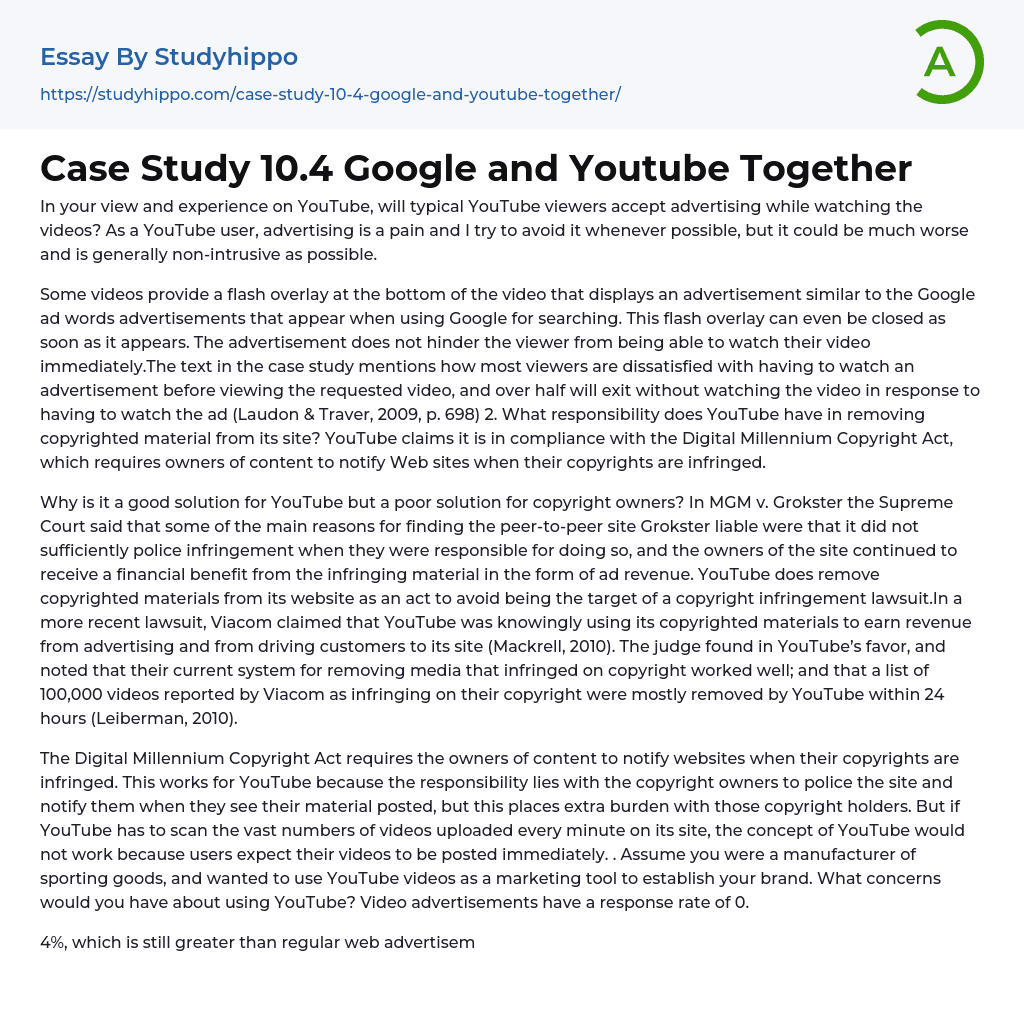

Case Study 10.4 Google and Youtube Together Essay Example
Do you think the average YouTube viewer is receptive to advertising during video viewing based on your personal experience and observation? Although I tend to avoid advertising as a YouTube user, it is relatively non-intrusive and could be much more disruptive.
Some videos feature a flash overlay at the bottom that shows an ad similar to Google AdWords. The ad can be closed immediately without disrupting the video. Although many viewers dislike watching ads before their desired video, over half will abandon the video if forced to watch an ad (Laudon & Traver, 2009, p. 698). In terms of copyright, YouTube claims to follow the Digital Millennium Copyright Act, which mandates that copyright owners alert websites when their content is infringed.
Despite being a successful solution for YouTube, the effectiveness of its approach to copyright is questionable. In MGM v. Grokster, the Su
...preme Court ruled against Grokster for failing to adequately police infringement and benefiting financially from infringing content. Unlike Grokster, YouTube removes copyrighted material from its site to avoid lawsuits. However, in Viacom's lawsuit against YouTube, it was claimed that YouTube knowingly used copyrighted content to earn ad revenue and draw traffic. The judge ruled in favor of YouTube, citing their efficient system for removing infringing media and the quick removal of 100,000 videos reported by Viacom within 24 hours.
The obligation to notify websites of copyright infringement falls on content owners as per the Digital Millennium Copyright Act. YouTube functions accordingly as copyright owners are responsible for monitoring the site and giving notice when they discover their content being posted. However, this puts an additional burden on the copyright holders. If YouTube had
to screen the enormous amounts of videos being uploaded every minute, the platform would lose its essence as users expect instant video posting. As a sporting goods manufacturer looking to promote your brand via YouTube videos, what apprehensions would you have regarding its use? It should be noted that video ads have a 0 response rate.
As a sporting goods manufacturer considering YouTube video ads as a significant part of my advertising budget, I am not impressed by the 4% viewer retention rate, which surpasses regular web ads such as banner ads. I anticipate that a substantial portion of the audience would skip or block my ad, resulting in a potentially negligible return on investment. Additionally, copyright concerns weigh heavily since approximately 25% of YouTube videos contain copyrighted material, comprising more than half of total views. Lawsuits could ensue if advertisements appear on videos with infringing material. Ultimately, the audience's acceptance of the ad is a pivotal factor.
YouTube's extensive audience could have a significant impact on your brand, either positively or negatively, and its outcomes are difficult to predict. For instance, the Old Spice-guy video ad and subsequent campaign had a beneficial effect, eliciting a positive reaction and a remarkable level of user participation. Conversely, ESPN's attempt to promote Monday Night Football on the YouTube landing page had unfavorable consequences. Offensive remarks belittling American football in favor of "world game" inundated the comments section within hours (Laudon & Traver, 2009, p. 00). 4.
Google claims that its Flash animations at the bottom of the video screen are clicked ten times more often than standard banner ads, but whether this response rate can be sustained over a five-year
period is debatable. Although this rate is reasonable given the relatively low response rates to online advertising, users notice these ads because they are focused on watching content they searched for. However, sustained increased response rates over the long term are unlikely as viewers become more aware of these new types of advertisements and try to avoid them, treating them like any other ad. As a typical viewer, I often close the ads that show up while watching a YouTube video because they take up part of the screen and interfere with the content I'm trying to watch; thus, I believe they are ineffective.
Works Cited: Laudon, K.
, ; Traver, C. wrote about E-Commerce in 2009 as presented in Leiberman, D.'s work.
(2010, June 24). A verdict was reached in favor of Google and YouTube in Viacom's $1 billion lawsuit. The article can be retrieved from USA Today on October 22, 2010: http://www.usatoday.com/tech/news/2010-06-23-google-viacom-copyright-lawsuit_N.
According to ArtsHub (2010), YouTube has found a safe harbour (Mackrell, 2010, July 19). The source can be retrieved at: http://www, accessed on October 22, 2010.
The article about YouTube finding a safe harbor can be found at artshub.com.au/au/news-article/opinions/publishing-and-writing/y%20outube-finds-a-safe-harbour-181725?sc=1 within a
tag.
- Sales Promotion essays
- Advertising campaign essays
- Advertisement essays
- Advertising essays
- Anheuser-busch essays
- Audience Theory essays
- Brand essays
- Brands essays
- Competitor Analysis essays
- Consumer essays
- Detergent essays
- Marketing Management essays
- Marketing Mix essays
- Marketing Plan essays
- Marketing Research essays
- Marketing Strategy essays
- New Product Development essays
- Point Of Sale essays
- Price essays
- Procurement essays
- Product essays
- Product Differentiation essays
- Product Placement essays
- Promotion essays
- Promotion And Marketing Communications essays
- Research Design essays
- Retailing essays
- Trademark essays
- Agreement essays
- Business Law essays
- Common Law essays
- Community Policing essays
- Constitution essays
- Consumer Protection essays
- Contract essays
- Contract Law essays
- Copyright Infringement essays
- Court essays
- Crime essays
- Criminal Law essays
- Employment Law essays
- Family Law essays
- Injustice essays
- Judge essays
- Jury essays
- Justice essays
- Lawsuit essays
- Lawyer essays
- Marijuana Legalization essays
- Ownership essays



